How to Grow Basil Plants – An International Herb
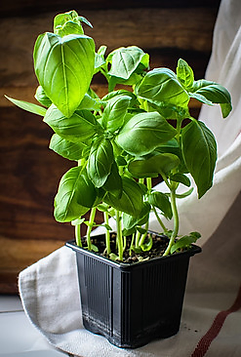
How to Grow Basil Plants – An International Herb
It’s summertime! Your vegetables are growing large and strong, the tomatoes are ripening, and your mouth is watering thinking of all the delicious flavors you’ll soon be tasting. What better way to enhance the natural flavor of these vegetables than by adding home grown basil? Learn how to grow basil plants and share some favorite recipes containing this international herb.
(Some of the links within this post are affiliate links on which I receive a small compensation from the sale of certain items with no extra cost to you.)
(As an Amazon Associate I earn from qualifying purchases.)
How To Grow Basil Plants
Basil plants (Click and Grow) are relatively easy to grow. They like full sun, good, organic soil full of nitrogen that is well drained, and soil that is slightly moist at all times but not soggy. Soggy soil will eventually rot the roots. If you live in a sunny, hot location, water every 1 to 2 days.
If your basil is in a pot, be sure it has a drainage hole and is placed in a spot that receives at least 6 hours of full sun. Before the first sign of frost, bring your basil inside. Basil is very sensitive to temperature change. It prefers a steady warm temperature with lots of sunlight.
If your basil plant is planted in the ground, it can live up to 2 years before you need to purchase another. Again, be sure it has good organic soil that drains properly and also receives at least 6 hours of sunlight. Do not crowd the plant.
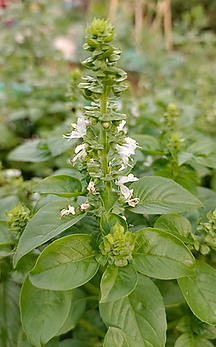
Apply mulch around the plant after the soil has warmed up. Do not smother the plant, though. Keep the area close to the stems free of mulch.
You want the plants to put all their effort into producing leaves so pinch off the flowers that start to grow. Also, pinch off groupings of leaves above the nodes to encourage bushier growth.
One alternative to growing basil outside is growing basil in a grow box or grow tent.
Trouble Shooting
If your basil plant wilts or is yellowing, it is probably due to over or under watering. Be sure to keep the soil moist to the touch but not soggy.
You know that the soil is too wet if:
-
your leaves are yellowing from the bottom up
-
the soil has a foul odor
-
there is stunted growth
-
you have drooping and wilted leaves
If the watering does not seem to be the issue, your plant may be planted too closely to other plants causing it not to absorb nutrients from the soil. Proper spacing of plants is essential.
Basil is susceptible to basil downy mildew. The mildew may appear to have black spots and/or the basil leaves turn yellow in the center or can have a blackish tinge with curled edges. The mildew may also cause a black, sooty discoloration under the leaves. This is a pervasive disease. Once identified in your garden, dig out the basil plant and throw it in the trash. Do not compost it. In order to prevent the problem, plant your basil with sufficient space so air can circulate around it. The mildew thrives in wet areas, so control the amount of moisture in the area where you plant the basil.
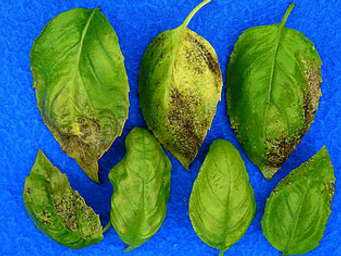
Companion Planting
Plant basil with marigolds to create a natural resistance to mosquitos. Their dual fragrance will deter insects from settling into your garden and will form a natural shield of protection for you and your guests. Basil also repels spider mites and aphids.
Basil should not be planted next to sage, rue, mint or rosemary. These herbs will naturally overtake the soil thus leaving the basil roots with less nutrients and little space to grow and thrive. They also do not have the same water and sunlight requirements as basil.
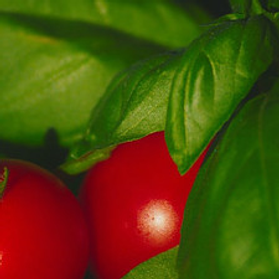
DO plant basil next to tomato plants. They naturally repel hornworms that are lethal to tomatoes.
Some companion herbs for basil include chamomile and oregano. Some gardeners say that by planting basil in close proximity to these herbs, the herbs will enhance the flavor of the basil.
One other herb that is a good bedfellow for basil is borage. This herb naturally extracts nutrients from the soil and brings them closer to the basil roots. Borage has a pretty purple color that enhances the
look of your garden, naturally attracts pollinators and it is also edible.
Do NOT plant different varieties of basil together. They will cross pollinate and eventually one taste will overtake another leaving the same tasting basil regardless of the variety.
Harvesting Basil
(As an Amazon Associate I earn from qualifying purchases with no extra cost to you.)
If you pinched off the flower heads and groups of leaves, you should have an abundance of basil leaves.
Snip the leaves from the top down.
Cut the stems right above the next node of leaves.
Never cut from the bottom.
Once you’ve harvested the leaves from the top down, you will soon see new growth to replace the old. This practice encourages more leaves and a bushier plant.
How to Freeze Basil
Basil is good to have all year round. One easy way to preserve your basil is by freezing.
-
pick leaves
-
wash and dry leaves
-
place in food processor or blender with a tiny bit of olive oil
-
pour into an ice cube tray
-
pop out cubes
-
store in a zip-loc bag in the freezer
-
pop them into your favorite recipe
A Little History
According to myspicer.com/a division of Rocky Mountain Spice Company:
“Basil has been around for over 4,000 years. Throughout history, basil was believed to have almost magical powers. It was used as an antidote for snake bites, and was believed to give strength during religious fasting.
It was found in mummies in Egypt because the ancient Egyptians used this herb for embalming.
In Greece, basil was a symbol of mourning. The herb was referred to as basileus phuton, meaning magnificent, royal or kingly herb.”
Basil is used around the world from European countries to southern Asia. There are basically two kinds of basil, sweet basil and Thai basil. Both are used frequently in a variety of recipes.
A Couple of Simple Recipes
15 Minute Thai Basil Chicken from Host the Toast, A Kitchen Kaper Blog
Ingredients:
-
2 tablespoons vegetable oil
-
3 tablespoons oyster sauce
-
2 tablespoons soy sauce
-
2 tablespoons fish sauce
-
3 tablespoons sugar
-
1 red bell pepper, chopped
-
8 ounces green beans
-
1 1/2 pounds boneless, skinless chicken thighs, coarsely chopped
-
4 sliced shallots
-
4 cloves garlic, minced
-
4 minced Thai chilies, or to taste
-
1 cup very thinly sliced fresh Thai basil leaves
-
Jasmine rice, to serve
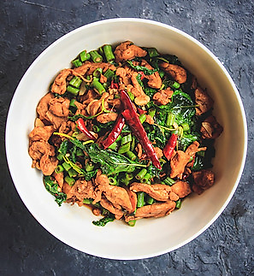
Instructions:
-
Heat the oil in a wok or heavy, high-walled skillet over high heat. As the wok is heating up, whisk together the oyster sauce, soy sauce, fish sauce, and sugar until well-combined. Set aside.
-
Add the bell pepper and green beans to the hot wok. Stir-fry for one minute. Add in the chicken and stir-fry, breaking apart as you go, until beginning to brown, about 2 minutes.
-
Stir in the shallots, garlic, and Thai chilies. Cook until fragrant, about 1 more minute. Then, pour in the prepared sauce. Continue to cook until the sauce begins to glaze onto the meat, about 1-2 more minutes.
-
Stir in the Thai basil leaves and cook until the chicken is completely cooked through, the basil is wilted, and the liquid has mostly evaporated. Serve warm with rice.
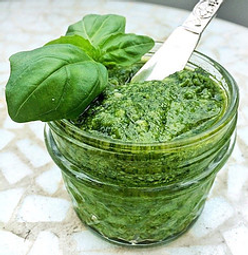
Basil Pesto by Andrea Migliaccio, Great Italian Chefs
Ingredients: (amounts transcribed from grams)
-
7 1/16 oz of sweet basil leaves
-
1 1/16 oz of ice
-
1 3/4 oz of pine nuts
-
1/4 garlic clove
-
1/8 oz of salt
-
5 1/3 oz of extra virgin olive oil
-
1 3/4 oz of Parmesan, grated
-
1 1/16 oz of pecorino, grated
Instructions:
1. Blanch the basil in salted boiling water, then refresh in iced water. Squeeze excess water and blitz in a blender with the ice
-
7 1/16 oz of basil leaves
-
1 1/16 oz of ice
2. Add the pine nuts, garlic, salt and extra virgin olive oil and blend
-
1 3/4 oz of pine nuts
-
1/4 garlic clove
-
1/8 oz of salt
-
5 1/3 oz of extra virgin olive oil
3. Finally, stir through the cheeses and use. Alternatively, store in an airtight container in the fridge for up to 3 days
-
1 1/16 oz of pecorino, grated
-
1 3/4 oz of Parmesan, grated
Simple Basil
As you can see, basil is a rather simple herb to grow. Supply it with good nitrogen based soil, proper sunlight, the correct amount of water and room to grow and you will harvest many leaves of tasty basil. For an introduction to herbs, click on my post, Planting Herbs in a Garden.
I hope you enjoyed this post and learned a lot about basil. Please leave a comment below and share it with others you feel will benefit from this article.

